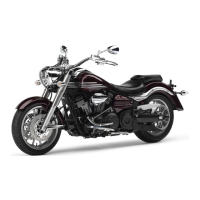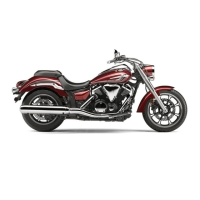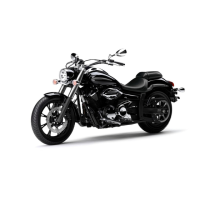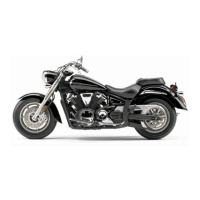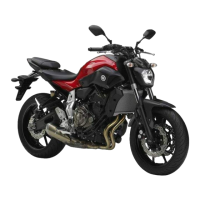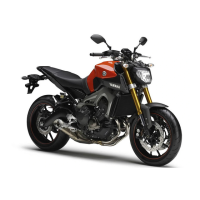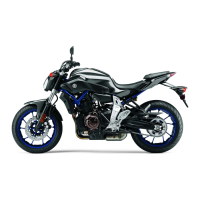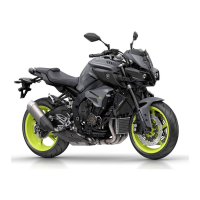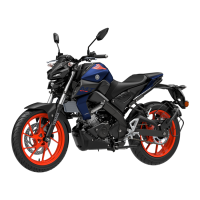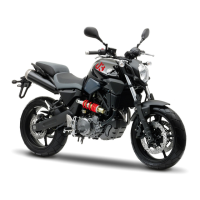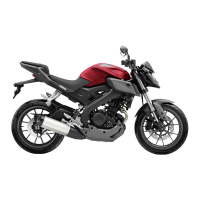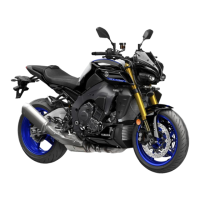Do you have a question about the Yamaha Mio Amore AL115 and is the answer not in the manual?
Explains symbols like WARNING, NOTICE, and TIP used throughout the manual for clarity and safety.
Emphasizes owner responsibility, safe riding techniques, and awareness of traffic for accident prevention.
Details essential protective apparel, precautions against carbon monoxide, and road hazard awareness.
Provides guidance on loading cargo safely and using genuine Yamaha accessories for optimal performance.
Warns about aftermarket parts and specifies approved tires for optimal performance and safety.
Outlines the importance of approved helmets and how to wear them correctly for maximum protection.
Identifies key components through left and right view diagrams of the motorcycle, listing their locations.
Explains the functions of the main switch and how to lock and unlock the steering for security.
Describes the function of indicator lights, speedometer, odometer, and fuel meter on the instrument panel.
Details the functions of left and right handlebar switches: dimmer, turn signal, horn, and starter.
Explains operation of front/rear brake levers, fuel tank cap, and fuel system warnings.
Details the catalytic converter, starter (choke) lever, and kickstarter mechanisms for engine operation.
Describes how to open/close the seat and use helmet holders for secure storage.
Covers the under-seat storage compartment and luggage hook, including load limits and usage tips.
Guides on starting cold and warm engines, including proper warm-up procedures for engine longevity.
Details how to start moving, use mirrors, signals, and control throttle for acceleration and deceleration.
Explains safe braking methods and warns about slippery road conditions and downhill braking.
Offers tips for saving fuel and outlines the critical engine break-in period procedures for longevity.
Provides instructions for safe parking, considering hot components and vehicle stability.
Discusses the benefits of correct use and maintenance for preserving motorcycle performance and lifespan.
Introduces the owner's tool kit and the importance of periodic inspection, adjustment, and lubrication.
Presents a detailed chart outlining maintenance jobs at specific mileage intervals and annual checks.
Provides step-by-step instructions for removing and reinstalling various body panels for maintenance access.
Guides on checking the spark plug condition and the engine oil level for optimal performance.
Details the procedure for changing engine oil and cleaning the oil strainer.
Covers checking and changing final transmission oil and servicing air filter elements.
Discusses carburetor function and adjusting engine idling speed for proper operation.
Explains how to adjust throttle cable free play and the importance of valve clearance checks.
Covers tire air pressure, inspection, tread depth, and spoke wheel care for safe operation.
Details checking and adjusting front/rear brake lever free play and brake pad/shoe wear.
Outlines procedures for changing brake fluid, checking V-belt, and lubricating control cables.
Guides on inspecting the front fork, steering bearings, and wheel bearings for smooth operation.
Covers battery electrolyte level checks, storage, and fuse replacement procedures.
Provides instructions for replacing headlight/signal bulbs and an overview of troubleshooting.
Offers a structured approach to diagnosing and resolving common operational issues.
Details how to clean the motorcycle, including specific instructions for different parts and conditions.
Provides guidelines for short-term and long-term storage to protect the scooter from elements and corrosion.
Lists physical dimensions, weight, engine type, displacement, oil, fuel capacity, and carburetor details.
Outlines transmission type, gear ratios, chassis details, and front tire specifications.
Provides details on wheels, brakes, suspension types, electrical system, battery, and lighting.
Explains how to locate and record key, vehicle, and engine identification numbers for reference and registration.
| Displacement | 113.7 cc |
|---|---|
| Fuel System | Carburetor |
| Lubrication System | Wet sump |
| Frame Type | Underbone |
| Front Suspension | Telescopic fork |
| Rear Suspension | Unit Swing |
| Front Tire | 70/90-14M/C 34P |
| Rear Tire | 80/90-14M/C 40P |
| Overall Height | 1, 050 mm |
| Engine Type | Air-cooled, 4-stroke, SOHC |
| Bore x Stroke | 50.0 mm x 57.9 mm |
| Ignition System | CDI |
| Starting System | Electric & Kick |
| Clutch Type | Automatic centrifugal |
| Transmission Type | Automatic |
| Rear Brake | Drum |
